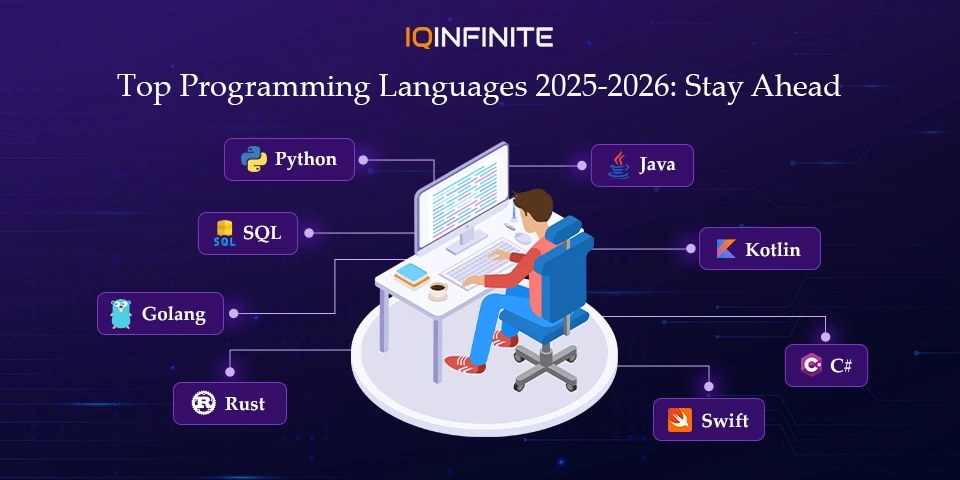Top Programming languages in 2025-2026. What you need to learn to stay ahead

Technology is moving at lightning speed and so is the world of software development. From AI and automation to cloud computing, blockchain and Web3, the tools that shape our digital future are evolving every day. In this rapidly shifting landscape, the programming languages you choose to master can make or break your career growth.
Whether you’re just starting your coding journey or are an experienced developer aiming to level up, learning the right languages is no longer optional it’s the key to staying relevant, competitive and future-ready.
Here’s a look at the top programming languages dominating 2025-2026 and why they deserve a place on your learning roadmap.
1. Python - The All-Rounder King
Use cases:
• AI/ML models (TensorFlow, PyTorch)
• Web development (Django, Flask, FastAPI)
• Automation scripts & DevOps
Who should learn: Beginners, data scientists, AI/ML engineers, backend developers.
2. JavaScript / TypeScript - Web & Beyond
Use cases:
• Frontend development (React, Angular, Vue)
• Backend (Node.js, Deno)
• Mobile apps (React Native, Ionic)
Trends for 2026: Web3 apps, Progressive Web Apps (PWAs) and full-stack JavaScript.
Who should learn: Full-stack devs, mobile/web developers, startup founders.
3. Java - The Enterprise Powerhouse
Use cases:
• Large-scale enterprise software
• Android development (Kotlin is also key, but Java remains strong)
• Cloud-native apps with Spring Boot
Future outlook: Java is evolving with Project Panama & Loom, making it lightweight and future-proof.
Who should learn: Enterprise devs, backend engineers, mobile developers.
4. Go (Golang) - The Cloud & AI Infrastructure Hero
Use cases:
• Cloud platforms (Docker, Kubernetes are written in Go)
• Microservices
• Backend APIs with blazing performance
Who should learn: Cloud engineers, DevOps pros, backend developers.
5. Rust - The Future of Systems Programming
Use cases:
• OS development & embedded systems
• Blockchain/Web3 platforms
• High-performance apps requiring safety + speed
Outlook: Likely to replace C++ in many domains by 2026.
Who should learn: Systems programmers, blockchain developers, security-focused engineers.
6. Kotlin - The Android & Cross-Platform Star
Use cases:
• Android apps
• Backend (Ktor framework)
• Cross-platform mobile apps (Kotlin Multiplatform)
Who should learn: Mobile developers, full-stack engineers.
7. Swift - Apple Ecosystem’s Backbone
Use cases:
• iOS & iPadOS apps
• AR/VR apps (Apple Vision Pro apps)
• macOS apps
Future outlook: With Apple’s expansion into AR/VR, Swift skills = premium demand.
Who should learn: iOS developers, AR/VR enthusiasts.
8. SQL & Data Languages (R, Julia, Scala)
Use cases:
• SQL → Databases & data management
• R → Statistical computing & data analysis
• Julia → Scientific computing & AI research
• Scala → Big Data with Apache Spark
Who should learn: Data analysts, data engineers, ML researchers.
9. C# - The Game & Enterprise Player
Use cases:
• Game development (Unity)
• Web apps with .NET Core
• Enterprise desktop software
Who should learn: Game developers, enterprise app developers.
How to Choose the Right Programming Language
1. Match with Career Goals
• AI & Data Science → Python (dominant in ML, AI, analytics)
• Web & Frontend Apps → JavaScript / TypeScript (backbone of modern web)
• Systems & High-Performance Computing → Rust / Go (fast, efficient, scalable)
2. Follow Industry Demand
• Enterprise & Large Organizations → Java / C# (stable, trusted, widely adopted)
• Startups & Agile Teams → JavaScript / Go (rapid development, scalability)
• Research & Academia → Python / Julia (scientific, data-driven focus)
3. Future-Proof Your Skills
Don’t just stop at one language. Build a balanced toolkit:
• One versatile, mainstream language (Python, JavaScript or Java)
• One niche, future-focused language (Rust, Go or Julia)
Conclusion
The future belongs to developers who adapt, upskill and align their learning with industry trends. Start today and you’ll be ready for tomorrow.
